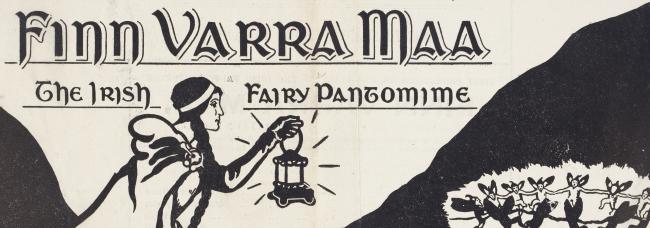A Christmas Pantomime in 1917
A Christmas pantomime staged at the Theatre Royal in Dublin in December 1917 offers a fascinating insight into Irish cultural nationalism twenty months after the Easter Rising. Finn Varra Maa (The Irish Santa Claus): An Irish Fairy Pantomime in Four Acts, was written by Thomas Henry Nally (1869–1932), with a score by Irish composer Geoffrey Molyneaux (1882–1957). The family-friendly production featured over a hundred performers, many of them schoolchildren, playing the roles of leprechauns, banshees, sheeogues, sprites, and imps. The title of the work is derived from the Irish for 'good Finbar' - Fionnbharr or Finvarra maith. The title character, played by Brefni O’Rorke, was based on Irish mythological hero Fionn mac Cumhaill, reimagined by Nally as an old Irish version of Santa Claus, hailing from Connemara.
He comes to the homes of the poor and the lowly, With sacks full of playthings for girls and good boys, And down thro’ the chimneys at midnight comes slowly, To fill up their stockings with fairy-made toys.
An excerpt from Granny's Song in 'Finn Varra Maa'
Introducing a Gaelic Santa Claus
Denouncing the anglicisation of Ireland and the loss of Irish culture, the play was a nationalist attempt to replace the foreign import of Santa Claus with a distinctly Gaelic alternative:
‘In England they have one they call “Father Christmas”,
A grey-bearded Russian they dub “Santa Claus”
But here in the fair land of Erin we dismiss
The Muscovite fairies with white-whiskered jaws.
They’ve stolen our Poetry, Music, and Stories,
Our Orators, Statesmen, our Letters and Art.
But they shall not rob us of our ancient glories,
They’re guarded too well in each true Irish heart’.
Censoring the Fairies
Well-received from the outset, the pantomime enjoyed further success and notoriety in January after it was subject to censorship. A comedic anti-conscription exchange between the bailiff Sheumas Pat and an RIC policeman was found to be in contravention of the Defence of the Realm act:
‘You’re in the “Force”, God help you, Keogh
And you’ll be bound some day to go.
They want to let the Germans see
Our sable-belted R.I.C [Royal Irish Constabulary] . . .
‘Twill be a dreadful sight to see!
’Tis riddled like a sieve you’ll be.’
The actors adhered to the censorship with a new, tongue-in-cheek exchange:
Constable: 'Stop! Not a word about the war.'
Sheumas Pat: 'Now, what on earth am I to say? / The Censor’s cut my lines to-day.'
In fact, producers were far more concerned about the disapproval of the Catholic Church. To avoid potential criticism for situating a Christmas production in pagan Ireland, Finn Varra Maa introduced the character of an ‘ancient Christian Knight’, Caílte Mac Rónáin, to drive home a Good versus Evil narrative steeped in Christianity.
A Playbill Designed by Grace Plunkett
The playbill cover for Finn Varra Maa was designed by Grace Gifford Plunkett. Gifford was a talented illustrator and caricaturist, with strong nationalist sympathies. She began her career by contributing illustrations to numerous nationalist and suffrage newspapers, including Irish Life, the Shanachie, the Irish Citizen, and the Irish Review. Gifford married 1916 revolutionary leader Joseph Plunkett on the eve of his execution at Kilmainham Gaol for his part in the Easter Rising. She was elected to the Sinn Féin executive in 1917 and used her artistic talents to promote Sinn Féin policies and election campaigns. In addition to her political activism, Gifford was deeply interested in theatre, and would go on to design Abbey Theatre costumes and to publish two collections of cartoons depicting Abbey Theatre actors and scenes: Twelve Nights at the Abbey Theatre (1929) and Doctors Recommend It: An Abbey Tonic in Twelve Doses (1930).
The Celtic Revival
Gifford’s design for Finn Varra Maa captures the intersecting human and fairy realms in the pantomime. The child in the foreground is most likely Padhar Bawn, a young boy of twelve who enters the fairy realm to rescue a young girl, Befind MacHugh, from the evil fairy Aoibill. The figure with him is probably Finn Varra Maa himself, or possibly Caílte Mac Rónáin. By highlighting the actors’ Celtic costumes – specially designed by Dun Emer Guild – and by using a stylised Gaelic font, Gifford’s playbill emphasised the production’s place within the Irish Celtic Revival. With its origins in the Protestant middle-class, the Celtic Revival was a popular movement advocating a rediscovery of Gaelic culture, literature, language and heritage, and the establishment of a distinctly Irish cultural identity. As a family-friendly theatrical production with strong political undertones, Finn Varra Maa demonstrates the increasing convergence of political and cultural nationalism in Ireland in the aftermath of the 1916 Rising.
This playbill features in the Decade of Centenaries exhibition, Roller Skates & Ruins, on view in Room 11 at the National Gallery of Ireland until 10 March 2024.
Further Reading
‘Censoring the Fairies: Funny Men’s Quaint Substitute for Deleted Lines.’, Freeman’s Journal, 10 January 1918: 2.
Joan FitzPatrick Dean, All Dressed Up: Modern Irish Historical Pageantry, Syracuse University Press, 2014.
T. H. Nally, Finn Varra Maa (The Irish Santa Claus). An Irish Fairy Pantomime in Four Acts, Dublin: The Talbot Press, 1917.
Marie Lynch, ESB CSIA Fellow
Published online: 2022
